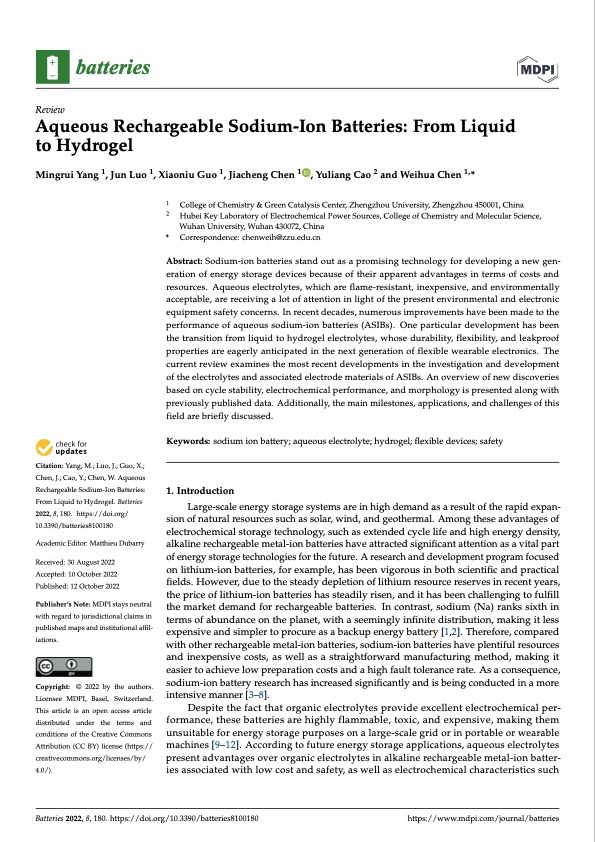
PDF Publication Title:
Text from PDF Page: 001
batteries Review Aqueous Rechargeable Sodium-Ion Batteries: From Liquid to Hydrogel Mingrui Yang 1, Jun Luo 1, Xiaoniu Guo 1, Jiacheng Chen 1 , Yuliang Cao 2 and Weihua Chen 1,* 1 2 * Correspondence: chenweih@zzu.edu.cn Abstract: Sodium-ion batteries stand out as a promising technology for developing a new gen- eration of energy storage devices because of their apparent advantages in terms of costs and resources. Aqueous electrolytes, which are flame-resistant, inexpensive, and environmentally acceptable, are receiving a lot of attention in light of the present environmental and electronic equipment safety concerns. In recent decades, numerous improvements have been made to the performance of aqueous sodium-ion batteries (ASIBs). One particular development has been the transition from liquid to hydrogel electrolytes, whose durability, flexibility, and leakproof properties are eagerly anticipated in the next generation of flexible wearable electronics. The current review examines the most recent developments in the investigation and development of the electrolytes and associated electrode materials of ASIBs. An overview of new discoveries based on cycle stability, electrochemical performance, and morphology is presented along with previously published data. Additionally, the main milestones, applications, and challenges of this field are briefly discussed. Keywords: sodium ion battery; aqueous electrolyte; hydrogel; flexible devices; safety 1. Introduction Large-scale energy storage systems are in high demand as a result of the rapid expan- sion of natural resources such as solar, wind, and geothermal. Among these advantages of electrochemical storage technology, such as extended cycle life and high energy density, alkaline rechargeable metal-ion batteries have attracted significant attention as a vital part of energy storage technologies for the future. A research and development program focused on lithium-ion batteries, for example, has been vigorous in both scientific and practical fields. However, due to the steady depletion of lithium resource reserves in recent years, the price of lithium-ion batteries has steadily risen, and it has been challenging to fulfill the market demand for rechargeable batteries. In contrast, sodium (Na) ranks sixth in terms of abundance on the planet, with a seemingly infinite distribution, making it less expensive and simpler to procure as a backup energy battery [1,2]. Therefore, compared with other rechargeable metal-ion batteries, sodium-ion batteries have plentiful resources and inexpensive costs, as well as a straightforward manufacturing method, making it easier to achieve low preparation costs and a high fault tolerance rate. As a consequence, sodium-ion battery research has increased significantly and is being conducted in a more intensive manner [3–8]. Despite the fact that organic electrolytes provide excellent electrochemical per- formance, these batteries are highly flammable, toxic, and expensive, making them unsuitable for energy storage purposes on a large-scale grid or in portable or wearable machines [9–12]. According to future energy storage applications, aqueous electrolytes present advantages over organic electrolytes in alkaline rechargeable metal-ion batter- ies associated with low cost and safety, as well as electrochemical characteristics such College of Chemistry & Green Catalysis Center, Zhengzhou University, Zhengzhou 450001, China Hubei Key Laboratory of Electrochemical Power Sources, College of Chemistry and Molecular Science, Wuhan University, Wuhan 430072, China Citation: Yang, M.; Luo, J.; Guo, X.; Chen, J.; Cao, Y.; Chen, W. Aqueous Rechargeable Sodium-Ion Batteries: From Liquid to Hydrogel. Batteries 2022,8,180. https://doi.org/ 10.3390/batteries8100180 Academic Editor: Matthieu Dubarry Received: 30 August 2022 Accepted: 10 October 2022 Published: 12 October 2022 Publisher’s Note: MDPI stays neutral with regard to jurisdictional claims in published maps and institutional affil- iations. Copyright: © 2022 by the authors. Licensee MDPI, Basel, Switzerland. This article is an open access article distributed under the terms and conditions of the Creative Commons Attribution (CC BY) license (https:// creativecommons.org/licenses/by/ 4.0/). Batteries 2022, 8, 180. https://doi.org/10.3390/batteries8100180 https://www.mdpi.com/journal/batteriesPDF Image | Aqueous Rechargeable Sodium-Ion Batteries Hydrogel

PDF Search Title:
Aqueous Rechargeable Sodium-Ion Batteries HydrogelOriginal File Name Searched:
batteries-08-00180-v2.pdfDIY PDF Search: Google It | Yahoo | Bing
Salgenx Redox Flow Battery Technology: Salt water flow battery technology with low cost and great energy density that can be used for power storage and thermal storage. Let us de-risk your production using our license. Our aqueous flow battery is less cost than Tesla Megapack and available faster. Redox flow battery. No membrane needed like with Vanadium, or Bromine. Salgenx flow battery
| CONTACT TEL: 608-238-6001 Email: greg@salgenx.com | RSS | AMP |